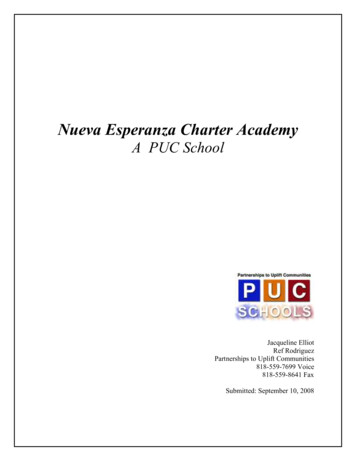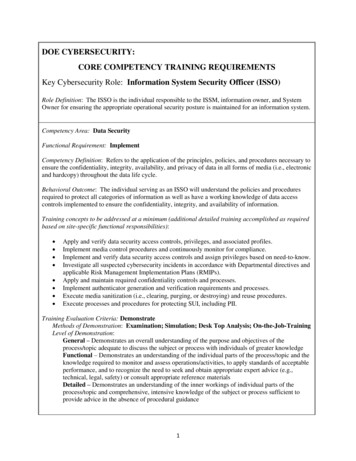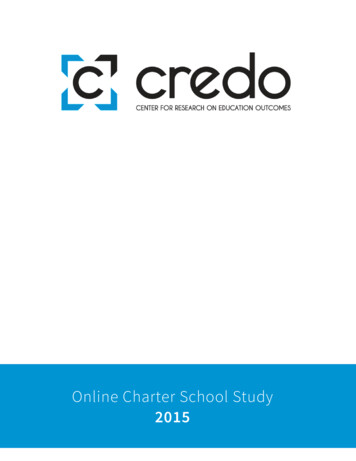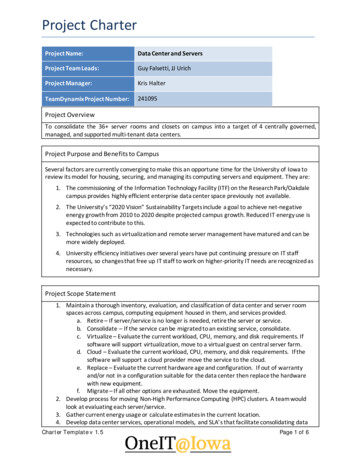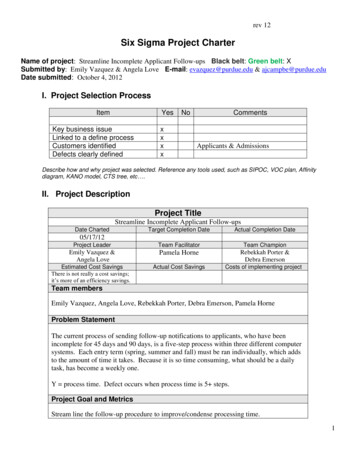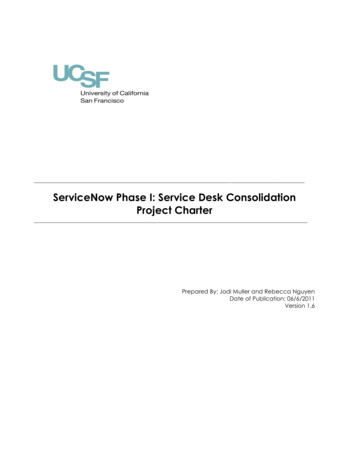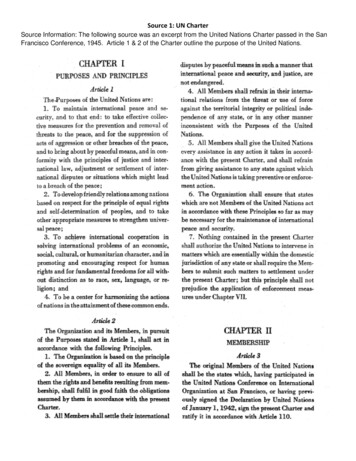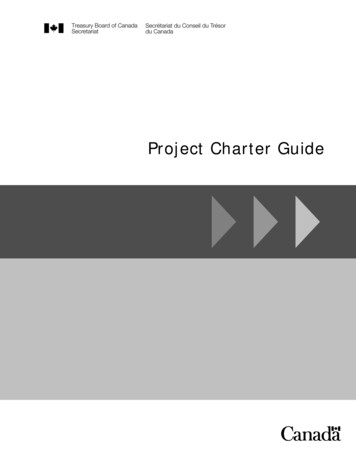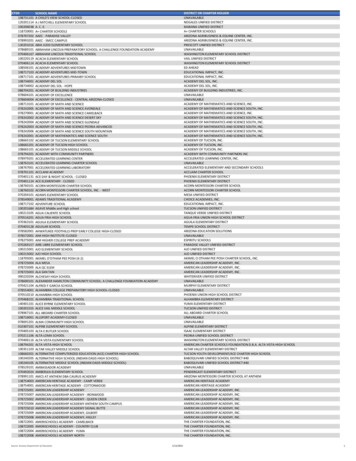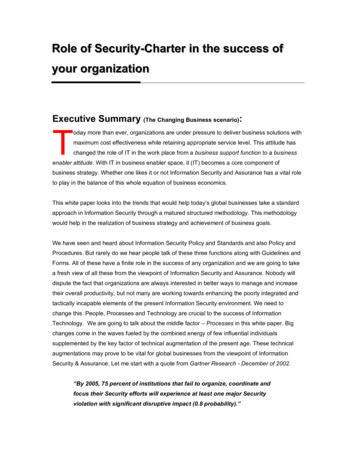
Transcription
RRoollee ooff SoffSeeccuurriittyy--CChhaarrtteerr iinn tthhee ssuucccceessss oyyoouurr oorrggaanniizzaattiioonnExecutive Summary (The Changing Business scenario):Today more than ever, organizations are under pressure to deliver business solutions withmaximum cost effectiveness while retaining appropriate service level. This attitude haschanged the role of IT in the work place from a business support function to a businessenabler attitude. With IT in business enabler space, it (IT) becomes a core component ofbusiness strategy. Whether one likes it or not Information Security and Assurance has a vital roleto play in the balance of this whole equation of business economics.This white paper looks into the trends that would help today’s global businesses take a standardapproach in Information Security through a matured structured methodology. This methodologywould help in the realization of business strategy and achievement of business goals.We have seen and heard about Information Security Policy and Standards and also Policy andProcedures. But rarely do we hear people talk of these three functions along with Guidelines andForms. All of these have a finite role in the success of any organization and we are going to takea fresh view of all these from the viewpoint of Information Security and Assurance. Nobody willdispute the fact that organizations are always interested in better ways to manage and increasetheir overall productivity, but not many are working towards enhancing the poorly integrated andtactically incapable elements of the present Information Security environment. We need tochange this. People, Processes and Technology are crucial to the success of InformationTechnology. We are going to talk about the middle factor – Processes in this white paper. Bigchanges come in the waves fueled by the combined energy of few influential individualssupplemented by the key factor of technical augmentation of the present age. These technicalaugmentations may prove to be vital for global businesses from the viewpoint of InformationSecurity & Assurance. Let me start with a quote from Gartner Research - December of 2002.“By 2005, 75 percent of institutions that fail to organize, coordinate andfocus their Security efforts will experience at least one major Securityviolation with significant disruptive impact (0.8 probability).”
Role of Security-Charter in the success of your organizationThis and other similar researches have led to the maturity of the field of Information Security andAssurance. Across the globe, people manning this newly formed division within organizationsknow how to protect company’s Information assets; they do understand in the real worldInformation Security is a service of multiple processes and not a single product. They alsounderstand the importance of Prevention and Detection as well as React and Respond. If that isthe case then these newly formed entities within global organizations are in good shape.But this is not always true! Let me explain why; for few seconds step out of your IT shoes anderase your IT knowledge and be one among the crowd. Let us now look into the two words;“Sign-up” and “Sign-in”. To the ordinary world they mean quite the same. Not to you when youare in your IT roles. They do have distinct meanings. Let me quote another example; Look intothese three words in the custom packaging conversations; “Pack&Mail”, “PakMail” and“PackMail”. Depending upon which part of the world you are in, they all point to different businessentities. But in casual conversations they sound much like the same. For example if you are inUK, they all might point to the same entity of www.packmail.co.uk. But here is US the first twoare two different entities. So you see the confusion?This is the foremost problem in the Information Security arena worldwide today. We need to havea common Information Security language/terminology. Everybody irrespective of theirgeographical location should interpret Information Security terminology in the same connotation.When we talk of Information Security Policies, internal Standards, Procedures and Guidelinesmost of us overlap the respective functional definitions of these terms. That is not good.Adoption of a Security Charter could help put some clarity within the enterprise with regard toInformation Security. Let’s look into what a Security Charter in an organization could look like,and what it could offer for the success of that entity. Let us take an example of how a midsizecompany with adequate availability of human resources at hand can design intelligent internalprocesses that could leverage its competitive edge by adopting a Security Charter.Security Charter:Security Charter is a system of practices that are agreed upon by the organization ingeneral for their prescribed Information Security practice. The phrase Security Charter isused when addressing Information Security at a higher level and represents the wholesystem of practices (some people call it best practices). A Security Charter should eventuallydisintegrate into multiple Security plans. A Security Plan caters to the needs of different businessdomains within the organizational framework. A Security Plan (at times also referred to asCopyright Asad Syed 2004. All rights reserved.-2-
Role of Security-Charter in the success of your organizationInformation Security Framework) should go into individual details in multiple functional areas ofInformation Security, some of those at an abstract level could be:1. Acceptable Resource Usage2. Access Control3. Business Continuity & Disaster Recovery4. Critical-incident Response5. Data Classification and Management6. Internal Audit7. Internal Standards8. Perimeter Protection9. Physical Access10. Privacy Principles11. Remote Access of IS resources12. Risk Assessment and Mitigation (Risk Management)13. Third-Party Resource Sharing14. Wireless CommunicationThe easiest way to understand a Security Charter is to look into some of the leading and matureCharters of the present age. Refer to the sidebar below. These Charters were designed bydifferent entities with different motivations and philosophies to achieve different objectives. All doaddress different needs of Information, but may not be adequate for Information Security arenawith one exception of ISO 17799. ISO/IEC 17799 procedures and practices cover a wide range ofissues by addressing a number of Control Requirements that need to be in place to achieve thebest-of-breed IT Security. For more Information on ISO 17799 please refer to the article .shtml.It is very important to understand that adoption of a specific Security Charter may not resolve allthe Security issues in an organization. This is where general decomposition of security functionalareas comes into play. It is equally important to know that a Security Charter by itself will create asystematic system in an organization. This system will increase the Security Awareness of theuser community and will largely benefit everybody in the end. When a system is introduced, it iseasier to manage from the management side and easier to adapt from the user side. This isexactly what a customized Security Charter could achieve.One can also follow these Charters on an AS-IS basis but then the domain of these charters mayshrink. Usually the real benefit comes when organizations create a hybrid model by taking goodpractices from each one of these Charters and create their own customized/proprietary SecurityCopyright Asad Syed 2004. All rights reserved.-3-
Role of Security-Charter in the success of your organizationCharter. This ensures that one gets a chance to drop the practices that are not suitable for one’sown organizational culture. This customized model could work towards an organizations ownadvantage. This customized hybrid Security Charter could further be named so that it reflects thepolicies of the organization. The best part in this whole process is that each organizationirrespective of its size and geographical location will get a chance to adapt to a system that willjust work for them, rather then getting one cookie cutter model that fits all.Charters of the present age:1. ANSI2. BS7799 security requirements established by the British Government.3. COBIT (Control Objectives for Information and Related Technology) requirements establishedby the Information Systems Audit and Control Association (ISACA).4. Common Criteria – ISO154085. Common Criteria (CC), a.k.a. ISO/IEC International Standard 15408, provides a charter and aframework for defining security requirements from both features and assurances side in theIT products and services.6. GAO’s FISCAM (Federal Information System Controls Audit Manual).7. GASSP (Generally Accepted System Security Principles) of I2SF (International InformationSecurity Foundation).8. ISO 13335 Guidelines for the management of IT ECTRTRTRTRTRTR13335-1:1996 Information technology - Part 1: Concepts and models for IT Security;13335-2: Information technology - Guidelines for the management of IT Security (GMITS)13335-2:1997 Information technology - Part 2: Managing and planning IT Security;13335-3:1998 Information technology - Part 3: Techniques for the management of IT Security;13335-4:2000 Information technology - Part 4: Selection of safeguards;13335-5:2001 Information technology - Part 5: Management guidance on network security;9. ITIL (the IT Infrastructure Library) is a customizable framework that defines how ServiceManagement is applied within an organization.10. Principles and Practices for Security of IT-Systems from NIST (National Institute of Standardsand Technology).11. Site Security Handbook from IETF (Internet Engineering Task Force).12. SysTrust requirements established by the AICPA (American Institute of Certified PublicAccountants).13. TickIT is about improving the quality of software and its application.Security Plan:Information Security Plan formulates how key-Information-Security-activities can beundertaken. In other words it should be the framework for achieving an organization’sstrategic business goals, objectives and maintenance of Information Resource Attributes &Services (IRA&S) like Authentication, Authorization, Availability, Confidentiality, Integrity and Nonrepudiation. For more information on IRA&S refer to the sidebar below.Copyright Asad Syed 2004. All rights reserved.-4-
Role of Security-Charter in the success of your organizationA Security Plan is a subset of a Security Charter. It identifies the rules that will be followed tomaintain the MSR (Referred to as Minimum Security Requirement) in an organization. The Planwill spell out specific details in all areas of Information Security Management. The detailed planusually starts from Information Security Policies and then moves on into Policy ImplementationTools (PIT) like internal Standards, Procedures, Guidelines and Forms.Information Security Policies are made to support and achieve the core businessobjective/strategy. Human resource policies are developed based upon the issues whereas theInformation Security Policy’s are developed based upon the (Risk Model) risks posed by variousfactors in Information System’s (IS) Functional areas at an abstract level. It is vital for theseInformation Security Policies to work; they should be endorsed by the executive management.Endorsement will get the required force and momentum into these Policies that can then becomethe driving force for the uniform enforcement of security policies in the entire stretch of theorganization domain.Definitions of Information Resources Attributes & Services (IRA&S): Authentication: Verifying the identity of an individual or other entity on the network or onthe system before allowing that person access to your organization’s data. Authorization: Ensuring that only those with successful authentication and appropriatepermission have the right to access (read, write, modify, and so forth) your organization’sdata. Availability: Ensuring that critical Information, services, and equipment are up and workingfor continuous and uninterrupted use by the user community. Confidentiality: Preventing unauthorized disclosure of any part of your organization’s datato any person(s) or entity within or outside your organization. Integrity: Preventing corruption, impairment, or unauthorized modification of yourorganization’s data and providing service(s) to validate the Integrity of Information. From amathematical point of view Integrity could also be defined as:Integrity Accuracy (Reliability) Completeness Non-Repudiation: Is a process of binding internal and external user communities with theactions performed on an organization’s data. The action could be an electronic transactionthat has an ability to add, change or delete a record in the database.Non-repudiation capability is necessary for an organization to bind a transaction to an entity,incase the initiator deny his/her involvement in the electronic transaction with a particularaction. In layman’s terms, it is equivalent to a paper-signature in the electronic world.In order to uniformly enforce and propagate identified Information Security Policies, enterprisesuse different Policy Implementation Tools (PIT). PIT include internal Standards, Procedures,Copyright Asad Syed 2004. All rights reserved.-5-
Role of Security-Charter in the success of your organizationGuidelines, Forms or any other security control that can effectively be used to enforce a securitypolicy. PIT has different coherent characteristics and distinct roles to play in the InformationSecurity Policy enforcement process. Based upon the needs and the culture of an organization, aunique set of Information Security Policies and supporting PIT can be designed for uniqueorganizational needs. This customized “Security Implementation Plan” could then become theInformation Security Framework for the organization.The Information Security Framework can then be merged with the enterprise documentmanagement system and be made to identify each document by a unique number, right fromSecurity Policies to PIT. This sort of hierarchy would establish a one-to-one relationship betweenall organization’s security policies and policy implementation tools (PIT). All these documentscould be organized using numbering schemes similar to IEEE (E.g. 802.11b) or ISO (E.g. ISO9001:2000) for document management and access purposes. This could then be served from acentral location via the document management system with appropriate authorization to the entireenterprise.Figure 1: Hierarchal view of Organization’s Security Policies and its relation with PIT.If we look into the individual steps of the whole process of evolving a Security Charter and thencoming up with a Security Plan and supporting PIT, then it could graphically be represented as inCopyright Asad Syed 2004. All rights reserved.-6-
Role of Security-Charter in the success of your organizationfigure 2. Figure 1 represents the hierarchal view of different components of PIT and theirrelationship with each other.Role of Awareness in Information Security:Agood number of information security breaches occur away from computer systems,terminal and access points. This includes, but is not limited too, careless placement ofprinted material, casual conversation and/or social engineering.Corporate/Security CharterCorporate Mission StatementInformation Security PlanInformation Security PoliciesPITInternal Standards Information Security PIT(Policy Implementation Tools)ProceduresGuidelines FormsFigure 2: Formula that derives PIT. (Relationship between Security Charter, Plan and PIT)Copyright Asad Syed 2004. All rights reserved.-7-
Role of Security-Charter in the success of your organizationSecurity Controls do play an important role in the protection of Information Resources, butSecurity Awareness has an equally important role to play in the space of Information Security &Assurance. Talking of Security Awareness without Security Training would be a blunder. So let’slook into both of these. Training and Awareness are twin functions in the IT space where onecannot stand without the other. Studies have shown that a company's biggest Security threat isits own employees. Based on this statement it could prove to be invaluable to organizations totake time to educate/train their employees about Information Security best practices andperiodically test employees to make sure they understand the Security basics.Training deals with the ‘how’ aspect of education and prepares oneself to actually deal with ascenario/eventuality by developing specific needed skills, whereas awareness deals with the‘what’ aspect of education. It is also the so-called ‘Social Marketing’ that counters the negativeeffects of ignorance. A list of Information Security Awareness materials and activities is availablefrom: ons are liable for the misuse of their technological infrastructure irrespective of who isdoing it. Another most important undocumented function of Information Security and Assurance isthe coordination of Information Security & Assurance activities within the organization’s differentfunctional groups like Legal, Human Resource and Physical Security. The importance of thiscoordination is often over estimated. But the fact is the better the coordination, the better theoverall security of that organization.Conclusion:We have seen that the world of Information Security and Assurance is full ofchallenges. Balancing the cost of implementing Security Practices versus the risk ofnot doing anything is the key to success here. To address these challenges there isa need for philosophical changes in the executive boardrooms for businesses toreduce their IT Risk exposure to an acceptable level. Disruptions are imminent but the potentialpayoffs are enormous for those people that align themselves with the right opportunity and withthe right strategy.A systematic approach of a Security Charter will certainly save time and money by developingorganization-wide Information Security and Privacy Plans, a uniform methodology forimplementing security enterprise-wide and much needed motivation and push for the workforce tomove in the right direction. Best of all it would aid in the nourishment of a security culture that isbadly missing in today’s enterprise environment. A Security Charter will in turn provide aCopyright Asad Syed 2004. All rights reserved.-8-
Role of Security-Charter in the success of your organizationconsistent approach and methodology for ongoing compliance of different industry specificregulations and for an organization’s internal monitoring. A Security Charter could eventuallybecome the launching pad for Process Certification and Accreditations like ISO-9001:2000, ITIL,ISO-17799, etc.We should all work towards the goal of creating a global commitment towards InformationSecurity and Assurance needs. We can do this better if we understand the underlying humanfactor beneath all these needs. We need to acknowledge that any System that ignores humannature WILL FAIL! Yet it is important to emphasize that Security at all times is always related tocreating a cultural change. A cultural change is not achieved without a personal change.Remember that change is a part of Revolution and seldom a Natural Phenomenon!About the writer:Asad Syed, CISSP, CISM is a freelance information security consultant and an amateur writer inChicago land. He is the ex-CTO of ITTechnics Com Inc. He has done Information SecurityConsulting at a global level for industries like Banking, Credit-Card, Fast-Food, andPharmaceutical and now engaged with Healthcare industry in Chicago. He can best be reachedby email at Asad@AsadSyed.com.Disclaimer:The views about Security Charter, Policy and PIT in this white paper are solely that
Executive Summary (The Changing Business scenario): oday more than ever, organizations are under pressure to deliver business solutions with maximum cost effectiveness while retaining appropriate service level. This attitude has changed the role of IT in the work place from a business support function to a business enabler attitude. With IT in .
